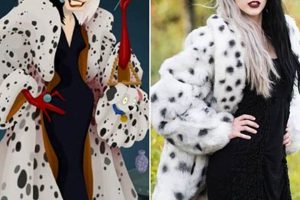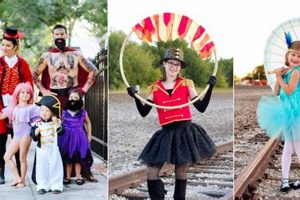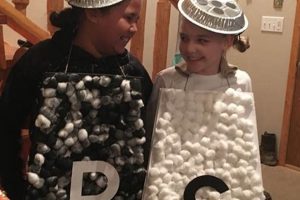The creation of personalized attire and accessories for the Da de los Muertos celebration represents a significant form of cultural expression. This undertaking involves individuals independently designing and constructing garments and adornments appropriate for commemorating deceased loved ones. An example includes hand-painting a traditional sugar skull design onto a face, complementing it with a self-made floral headpiece and a repurposed dress embellished with colorful ribbons.
Engaging in this crafting process fosters creativity, offers a deeper connection to the ancestral traditions of the holiday, and provides a cost-effective alternative to commercially produced outfits. Historically, such handmade elements were integral to the celebration, reflecting available resources and individual artistic skills within communities. The practice continues to promote resourcefulness and personalized remembrance.
The subsequent sections will elaborate on specific techniques for facial decoration, the construction of traditional floral headwear, and various strategies for assembling appropriate garments utilizing both new and repurposed materials, thereby facilitating the creation of a unique and meaningful presentation.
Tips for Creating a Da de los Muertos Ensemble
The following recommendations are intended to guide individuals in the development of an authentic and respectful Da de los Muertos presentation. Consideration should be given to both aesthetic appeal and cultural sensitivity during the construction process.
Tip 1: Facial Decoration Precision: Employ high-quality, hypoallergenic face paint and fine-tipped brushes. Practice the sugar skull design beforehand to ensure symmetry and control. Seal with a setting spray to prolong wear and minimize smudging.
Tip 2: Authentic Floral Headpiece Construction: Utilize a sturdy headband as a base. Secure artificial or dried flowers with floral wire and hot glue, prioritizing colors traditionally associated with the celebration, such as marigolds and cockscomb. Consider adding velvet ribbons for texture and visual interest.
Tip 3: Garment Selection and Modification: Opt for dark-colored clothing, such as black dresses or suits. Embellish with colorful ribbons, lace, or hand-painted details referencing sugar skulls or other iconic imagery. Avoid overly revealing or disrespectful attire.
Tip 4: Bone Structure Accentuation: Employ shading and highlighting techniques with makeup to accentuate the cheekbones, brow bone, and jawline. This adds depth and dimension to the calavera (skull) appearance.
Tip 5: Consider Cultural Appropriation: Be mindful to avoid caricatures or stereotypes. Research the holiday’s significance and traditions to ensure the presentation reflects respect and understanding. Authentic representations are favored.
Tip 6: Incorporate Personal Meaning: Consider adding elements that pay tribute to the specific individual being remembered. This could include their favorite colors, symbols representing their hobbies, or handwritten notes attached to the ensemble.
Tip 7: Ensure Comfort and Mobility: Prioritize comfort when selecting materials and designing the costume. Avoid overly restrictive clothing or accessories that may impede movement or cause discomfort during extended wear.
Implementing these suggestions allows for the creation of a visually striking and culturally sensitive Da de los Muertos representation, while fostering a deeper understanding of the holiday’s significance.
The subsequent section will address considerations for sourcing materials and managing costs associated with the creation of this type of presentation.
1. Creativity
Creativity functions as the primary impetus in the independent crafting of Da de los Muertos attire. The absence of mass-produced uniformity necessitates individual ingenuity in the design and execution of such ensembles. The extent to which one can personalize and imbue the costume with meaning is directly proportional to the level of creative input. For example, instead of purchasing a pre-made sugar skull mask, an individual might hand-paint a unique design incorporating personal symbols and colors, resulting in a more meaningful and visually distinctive representation.
The application of inventive problem-solving is crucial, particularly when utilizing repurposed or readily available materials. The creation of intricate floral headpieces from recycled paper or fabric scraps demonstrates this principle. Furthermore, creativity extends to the adaptation of traditional motifs, allowing for individual interpretations while remaining within the bounds of cultural respect. A seamstress could, for example, design a dress incorporating traditional Day of the Dead iconography using modern fabrics and patterns, demonstrating creativity while maintaining respect for cultural heritage.
In essence, creative expression is not merely an aesthetic component; it is the driving force behind personalized cultural celebration. By embracing inventiveness, individuals can create Da de los Muertos attire that holds deeper personal significance, promotes resourcefulness, and offers a respectful alternative to mass-produced options, thereby fostering a stronger connection to the holiday’s traditions.
2. Tradition
The crafting of Da de los Muertos attire is intrinsically linked to established customs and cultural practices. Ignoring the traditional underpinnings of the celebration can result in misrepresentation or cultural appropriation. A comprehensive understanding of these traditions is crucial for designing attire that is both aesthetically appropriate and culturally sensitive.
- Symbolic Iconography
Traditional Da de los Muertos iconography, such as sugar skulls (calaveras), marigolds (cempaschil), and skeletons (catrinas/catrines), carries significant symbolic weight. The calaveras represent the deceased and are often adorned with colorful patterns and personalized details. Marigolds, with their vibrant orange hue, are believed to guide the spirits back to the land of the living. Catrinas and catrines, with their elegant attire, satirize European aristocracy and celebrate the acceptance of death. When creating attire, incorporating these symbols accurately and respectfully is paramount, avoiding trivialization or misinterpretation. For example, the application of sugar skull designs on the face or clothing should adhere to traditional patterns and color schemes rather than utilizing modern, unrelated imagery.
- Regional Variations
Da de los Muertos traditions vary significantly across different regions of Mexico and Latin America. Attire that is considered appropriate in one region may be considered unsuitable in another. Researching the specific traditions of the region being honored is vital. For instance, some regions may e
mphasize indigenous dress styles, while others may incorporate elements of Spanish colonial fashion. Replicating the specific attire associated with a particular region demonstrates respect and cultural awareness. A costume inspired by Oaxaca, for example, may incorporate the vibrant textiles and intricate embroidery characteristic of the region’s indigenous communities. - Color Palette
The traditional color palette for Da de los Muertos attire is characterized by vibrant, saturated hues, particularly orange, yellow, purple, and pink. These colors symbolize life, death, and remembrance. While black is often used as a background color, the overall aesthetic should be celebratory and festive. Deviating from this color palette can diminish the authenticity of the attire. Avoid using muted or somber colors, as they may not align with the holiday’s celebratory spirit. A costume that incorporates bright, contrasting colors in the makeup and embellishments is more consistent with traditional practices.
- Respectful Representation of the Deceased
Da de los Muertos is primarily a celebration of remembrance and a way to honor deceased loved ones. Attire should reflect this solemn yet celebratory spirit. Avoid creating costumes that are overtly sexualized, disrespectful, or that trivialize death. Instead, focus on creating attire that pays tribute to the lives and legacies of those being remembered. This may involve incorporating personal items or symbols that were meaningful to the deceased. A costume might include a piece of jewelry or an accessory that belonged to the individual being honored, adding a personal and respectful touch.
Adherence to these traditional elements ensures that the creation of Da de los Muertos attire is not merely a superficial exercise in costume-making, but a genuine expression of cultural respect and remembrance. By understanding and incorporating these traditions, individuals can create attire that is both beautiful and meaningful, contributing to a more authentic and culturally sensitive celebration of the holiday.
3. Resourcefulness
Resourcefulness constitutes a pivotal element within the realm of crafting Day of the Dead attire. The creation process often necessitates the inventive utilization of available materials, due to budgetary constraints or a desire to minimize environmental impact. This creative problem-solving directly influences the final outcome of the costume, fostering individuality and reducing reliance on commercially produced alternatives. For instance, an individual might repurpose discarded fabric scraps into intricate floral embellishments, transforming waste into an integral component of the costume. Similarly, cardboard boxes could be creatively fashioned into ornate headpieces, demonstrating ingenuity and minimizing costs.
The ability to adapt existing items and transform them into thematic representations is a defining characteristic of resourceful costume creation. Thrift store garments can be modified and embellished to resemble traditional Mexican attire, reducing the need for purchasing entirely new clothing. Everyday household items, such as plastic bottles or egg cartons, can be repurposed into decorative elements, showcasing an ability to find value in the mundane. This approach not only minimizes financial expenditures but also promotes sustainability by reducing waste and encouraging creative reuse. An example is the transformation of plastic bottles into miniature calaveras, each uniquely decorated, demonstrating both creative adaptation and responsible resource management.
The significance of resourcefulness in this context extends beyond mere cost-effectiveness. It encourages a deeper connection with the traditions of the holiday, as individuals engage in hands-on creation and problem-solving. This process fosters a sense of accomplishment and personal investment, resulting in attire that is both visually striking and imbued with personal meaning. The ability to create something beautiful and meaningful from readily available materials is a testament to human ingenuity and underscores the importance of resourcefulness in fostering a more sustainable and culturally sensitive approach to Day of the Dead celebrations. While challenges may arise in securing specific materials or mastering certain crafting techniques, the overarching benefits of resourceful creation are undeniable, promoting both individual expression and environmental consciousness.
4. Individuality
Within the realm of Da de los Muertos attire construction, individuality manifests as a critical component, enabling personal expression and commemorating the unique lives of those being honored. This element moves beyond mere aesthetic variation, impacting the emotional resonance and cultural significance of the final presentation.
- Personal Symbolism Integration
Individual identity can be woven through the inclusion of symbols representing the deceased’s hobbies, profession, or personal beliefs. For example, a musician’s costume may feature miniature instruments or musical notes incorporated into the makeup or attire. Similarly, a teacher’s costume may include motifs representing books or educational symbols. This integration transforms the costume from a generic representation into a personalized tribute, reflecting the specific characteristics of the individual being remembered. This not only enhances the aesthetic appeal but also deepens the emotional connection, making the attire a heartfelt homage.
- Unique Design Elements
Deviation from standardized templates is a primary manifestation of individuality. Constructing unique garment patterns, creating original sugar skull designs, or incorporating unconventional materials are all indicative of a personalized approach. This involves not only aesthetic creativity but also a deeper engagement with the symbolic meaning of the holiday. Designing an original dress silhouette inspired by historical Mexican attire, or crafting a headpiece with personalized embellishments reflecting the deceaseds favorite flowers or colors, are examples of expressing unique design elements.
- Expressing Personal Grief and Remembrance
The design process itself can function as a medium for expressing personal grief and remembrance. The careful selection of colors, symbols, and materials can be guided by emotional considerations, allowing individuals to channel their feelings into the creation of the costume. This may involve incorporating elements that evoke specific memories or symbolize personal experiences shared with the deceased. For example, a family member may choose to include a specific flower or color that was associated with a cherished memory of their loved one. This transformation of grief into tangible expression can be a cathartic and meaningful part of the preparation process.
- Deviation from Stereotypical Representations
Individuals can challenge conventional portrayals of death and remembrance by subverting or reinterpreting traditional motifs. This may involve incorporating unexpected elements or using humor to challenge the somber connotations often associated with the topic of death. This deviation should, however, be executed with sensitivity and respect, avoiding any trivialization or mockery of the holiday’s significance. For instance, an individual could integrate traditional sugar skull ma
keup with modern fashion styles, creating a fusion that respects tradition while expressing a contemporary aesthetic. This approach can create a visually striking and emotionally resonant statement that challenges conventional expectations.
These facets of individuality are crucial for transforming Da de los Muertos attire from a mere costume into a deeply personal and meaningful tribute. The ability to express oneself through design, symbolism, and emotional engagement elevates the entire process, fostering a more authentic and respectful celebration of life and remembrance.
5. Accessibility
The concept of accessibility, in the context of creating Day of the Dead attire, pertains to the ease with which individuals, regardless of their economic standing, skill level, or physical limitations, can participate in the tradition. The do-it-yourself (DIY) approach inherently promotes wider participation by circumventing the financial barriers often associated with purchasing pre-made costumes.
- Economic Affordability
DIY projects mitigate cost barriers, enabling participation for those with limited financial resources. Utilizing recycled materials, thrift store finds, and readily available supplies significantly reduces expenses compared to purchasing commercially produced costumes. This allows individuals to allocate their budget to other aspects of the Da de los Muertos celebration, such as ofrendas or traditional foods. Example: A family might create sugar skull makeup using inexpensive face paints instead of purchasing elaborate masks, thereby ensuring their participation in the festivities.
- Skill Level Inclusivity
The DIY approach can accommodate varying skill levels, offering opportunities for both novices and experienced crafters. Simpler projects, such as painting a basic sugar skull design or assembling a rudimentary floral headpiece, require minimal technical expertise. More advanced individuals can undertake complex projects, such as sewing intricate garments or creating elaborate props. The availability of online tutorials and instructional guides further democratizes the process, providing guidance for individuals of all skill levels. A beginner might start with a simple project like decorating a pre-made hat with artificial flowers, while a more skilled artisan could create a hand-embroidered garment.
- Material Availability
Accessibility is also influenced by the ease with which necessary materials can be obtained. Projects that rely on readily available or repurposed materials are more accessible than those requiring specialized or expensive items. Utilizing materials such as cardboard, fabric scraps, and household paints broadens participation, especially in communities with limited access to craft stores. Example: A community organization might host a workshop where participants create decorations using recycled materials, promoting accessibility and sustainability.
- Adaptability for Physical Limitations
DIY projects can be adapted to accommodate physical limitations. Individuals with mobility issues can focus on smaller, more manageable tasks, such as painting sugar skulls or creating paper flowers. Adaptations can be made to tools and techniques to facilitate participation for those with disabilities. Example: Individuals with limited hand dexterity can use assistive devices or collaborate with others to complete tasks, ensuring their inclusion in the creative process.
The multifaceted nature of accessibility directly enhances inclusivity within Da de los Muertos celebrations. By reducing financial burdens, accommodating varying skill sets, ensuring material availability, and adapting to physical limitations, the DIY approach fosters a more equitable and participatory environment. This allows a greater number of individuals to engage with the cultural traditions of the holiday, fostering a stronger sense of community and shared remembrance.
6. Respect
Within the context of creating attire for Da de los Muertos, respect serves as a foundational principle, dictating appropriate design choices and influencing the overall presentation. The holiday is a deeply meaningful cultural event centered on honoring deceased loved ones. As such, the attire created for this occasion must reflect reverence and understanding of its origins and traditions. Failure to prioritize respect can lead to cultural appropriation, misrepresentation, or the trivialization of a sacred practice. For example, creating a costume that sexualizes the imagery associated with death or incorporates insensitive stereotypes demonstrates a lack of respect. Conversely, a costume carefully researched and thoughtfully crafted, paying homage to traditional elements while incorporating personal symbolism, exemplifies respect.
The practical implications of respecting cultural norms extend to various aspects of costume creation. This encompasses material selection, design motifs, and overall aesthetic. Choosing materials and patterns that reflect traditional Mexican artistry, or incorporating symbols significant to the deceased being honored, are tangible manifestations of respect. Furthermore, researching the specific traditions of the region or community being represented is crucial in avoiding inaccuracies or inappropriate portrayals. For instance, mimicking specific regional attire with accuracy and understanding, rather than creating a generalized “Mexican” costume, demonstrates a deeper level of respect and cultural awareness. A group creating costumes together might consult with community elders or cultural experts to ensure the authenticity and appropriateness of their designs.
In conclusion, respect is not merely an abstract consideration but a practical imperative in the construction of attire for Da de los Muertos. Prioritizing reverence for cultural traditions, conducting thorough research, and incorporating meaningful symbolism are essential steps in creating costumes that honor the deceased and celebrate the holiday with integrity. A lack of respect not only diminishes the individual’s participation but also risks perpetuating harmful stereotypes and undermining the cultural significance of the event. Therefore, a commitment to respect is crucial in ensuring that attire creation becomes a meaningful and enriching experience for all involved.
Frequently Asked Questions About Da de los Muertos Costume DIY
The subsequent section addresses commonly encountered inquiries pertaining to the independent creation of attire for the Da de los Muertos celebration. These responses aim to provide clarity and guidance on various aspects of costume construction, ensuring both aesthetic success and cultural sensitivity.
Question 1: What constitutes cultural appropriation in the context of designing attire for Da de los Muertos?
Cultural appropriation occurs when elements of Da de los Muertos traditions are utilized in a manner that is disrespectful, trivializing, or commodifying. This includes the use of stereotypical representations, the misinterpretation of sacred symbols, or the commercial exploitation of cultural practices without understanding or respect for their significance.
Question 2: How can one ensure the authenticity of a homemade sugar skull makeup design?
Authenticity can be enhanced by researching traditional sugar skull designs from va
rious regions of Mexico, paying particular attention to the use of specific colors, patterns, and symbolic motifs. Emulating these established designs, while adding personalized elements with sensitivity, contributes to a more authentic representation.
Question 3: What are the most cost-effective materials to employ when creating Da de los Muertos attire on a budget?
Cost-effective materials include repurposed fabrics, recycled paper, inexpensive face paints, and readily available craft supplies. Thrift store clothing can be modified and embellished, offering a budget-friendly alternative to purchasing new garments.
Question 4: How can an individual with limited crafting skills create a visually compelling Da de los Muertos costume?
Individuals with limited crafting skills can focus on simpler projects, such as decorating a pre-made hat with artificial flowers, creating basic sugar skull makeup designs, or embellishing existing clothing with colorful ribbons and lace. Online tutorials and instructional guides offer accessible resources for beginners.
Question 5: What considerations should guide the selection of colors and symbols for attire intended to honor a specific deceased individual?
The selection of colors and symbols should be guided by the preferences, personality, and significant aspects of the deceased individual’s life. Incorporating their favorite colors, hobbies, or symbols that held personal meaning contributes to a more meaningful and personalized tribute.
Question 6: How can respect for the traditions of Da de los Muertos be maintained when incorporating modern or unconventional elements into attire?
Respect can be maintained by ensuring that modern or unconventional elements do not undermine or trivialize the core symbolism and cultural significance of the holiday. Balancing contemporary aesthetics with traditional motifs, and approaching design choices with sensitivity and awareness, is essential.
In summary, creating attire for Da de los Muertos demands both creativity and cultural awareness. Authenticity, cost-effectiveness, and respect are paramount considerations, ensuring a meaningful and culturally sensitive representation.
The following section will address specific case studies and examples, providing practical illustrations of successful attire creation projects.
Day of the Dead Costume DIY
This exploration of the independent creation of attire for Da de los Muertos has elucidated several critical facets. Cultural sensitivity, resourcefulness, and personal expression are paramount considerations. The deliberate avoidance of cultural appropriation, coupled with a commitment to honoring tradition, remains central to responsible participation. The accessible nature of homemade costumes facilitates broader community engagement, fostering a deeper appreciation for the holiday’s significance.
As individuals embark on the construction of these meaningful ensembles, a continued emphasis on thoughtful design and respectful execution is essential. The Day of the Dead is a time of remembrance and cultural pride. With mindful creation, the final result is a unique personalized expression of love and remembrance.







